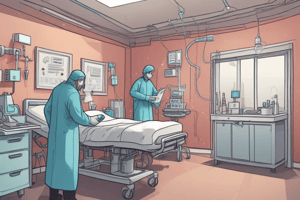Podcast
Questions and Answers
What is the primary method of transmission for communicable diseases?
What is the primary method of transmission for communicable diseases?
- Through the transmission of infectious agents or their products (correct)
- Through airborne transmission
- Through skin-to-skin contact
- Through contaminated food and water
What is the main goal of controlling communicable diseases?
What is the main goal of controlling communicable diseases?
- To eliminate the infectious agent
- To eliminate the disease globally
- To eradicate the disease locally
- To reduce the disease as a public health problem (correct)
What does R-naught (R0) measure?
What does R-naught (R0) measure?
- The infectiousness of the disease
- The spreadability of the infectious agent (correct)
- The severity of the disease
- The mortality rate of the disease
What does an R0 value of less than 1 indicate?
What does an R0 value of less than 1 indicate?
What is the term for the total elimination of an infectious agent from nature?
What is the term for the total elimination of an infectious agent from nature?
What is a key aspect of mastering infection control?
What is a key aspect of mastering infection control?
What type of infections are caused by an insect vector?
What type of infections are caused by an insect vector?
What is the term for a stop in the circulation of an infectious agent locally?
What is the term for a stop in the circulation of an infectious agent locally?
What is the purpose of Post-Exposure Prophylaxis (PEP)?
What is the purpose of Post-Exposure Prophylaxis (PEP)?
How soon should Post-Exposure Prophylaxis (PEP) be started after exposure?
How soon should Post-Exposure Prophylaxis (PEP) be started after exposure?
What is the duration of Post-Exposure Prophylaxis (PEP) treatment?
What is the duration of Post-Exposure Prophylaxis (PEP) treatment?
What is the purpose of HIV antibody tests?
What is the purpose of HIV antibody tests?
What is the name of the antigen produced before HIV antibodies?
What is the name of the antigen produced before HIV antibodies?
What is the recommended treatment for HIV infection?
What is the recommended treatment for HIV infection?
What is the name of the bacteria that causes tuberculosis?
What is the name of the bacteria that causes tuberculosis?
Why was TB declared a problem in the last decade?
Why was TB declared a problem in the last decade?
What is the primary way HIV is transmitted?
What is the primary way HIV is transmitted?
What has been the most successful countermeasure to the spread of HIV?
What has been the most successful countermeasure to the spread of HIV?
What is the primary way to prevent perinatal transmission of HIV?
What is the primary way to prevent perinatal transmission of HIV?
What is the result of adhering to HIV treatment regimen and having a suppressed viral load during pregnancy and childbirth?
What is the result of adhering to HIV treatment regimen and having a suppressed viral load during pregnancy and childbirth?
What is the purpose of post-exposure prophylaxis?
What is the purpose of post-exposure prophylaxis?
What is the term for the transmission of HIV from mother to baby during pregnancy, childbirth, and breastfeeding?
What is the term for the transmission of HIV from mother to baby during pregnancy, childbirth, and breastfeeding?
What is the importance of building health care infrastructure and capacity globally?
What is the importance of building health care infrastructure and capacity globally?
What is the term for giving antiretroviral prophylaxis to the baby after birth to reduce the risk of transmission?
What is the term for giving antiretroviral prophylaxis to the baby after birth to reduce the risk of transmission?
What is the primary mechanism by which plasmodia produce clinical symptoms?
What is the primary mechanism by which plasmodia produce clinical symptoms?
Which of the following is a primary prevention method for malaria?
Which of the following is a primary prevention method for malaria?
What is the purpose of confirmation of diagnosis in malaria?
What is the purpose of confirmation of diagnosis in malaria?
Why are treatment regimens for malaria region-specific?
Why are treatment regimens for malaria region-specific?
What is the goal of tertiary prevention in malaria?
What is the goal of tertiary prevention in malaria?
What is the current status of malaria vaccine development?
What is the current status of malaria vaccine development?
What is the primary mode of transmission of TB?
What is the primary mode of transmission of TB?
What is the stage of TB characterization by a negative skin test, a normal chest X-ray, and no signs or symptoms of the disease?
What is the stage of TB characterization by a negative skin test, a normal chest X-ray, and no signs or symptoms of the disease?
What is the term used to describe a person who has TB in their body but does not have symptoms of the disease?
What is the term used to describe a person who has TB in their body but does not have symptoms of the disease?
What is the outcome of untreated TB in about half of the patients?
What is the outcome of untreated TB in about half of the patients?
What is the term used to describe a person who has signs and symptoms of an active TB infection?
What is the term used to describe a person who has signs and symptoms of an active TB infection?
What is the result of modern chemotherapy in treating TB?
What is the result of modern chemotherapy in treating TB?
What is the term used to describe when a person with latent TB infection becomes active later in life?
What is the term used to describe when a person with latent TB infection becomes active later in life?
What was the impact of the COVID-19 pandemic on TB services in 2021?
What was the impact of the COVID-19 pandemic on TB services in 2021?
Study Notes
Communicable Diseases
- Communicable diseases are illnesses caused by infectious agents or their products that can be transmitted from an infected person, animal, or inanimate reservoir to a susceptible host.
- Infection control requires both individual and community measures.
R-naught (R0)
- R0 is the basic reproduction number, which measures the transmissibility of infectious agents.
- R0 indicates if a disease will spread or decline within a community and how far and how rapidly transmission will occur.
- R0 values:
- Less than 1: the disease will not spread and will eventually die out.
- 1: the disease will remain stable in the community but will not cause an epidemic.
- Greater than 1: the disease will spread and may cause an epidemic.
Control of Communicable Diseases
- Mastering infection control requires a thorough understanding of various infectious diseases.
- Disrupting the propagation of an infectious disease outbreak often only requires understanding how it is transmitted.
HIV/AIDS
- HIV is a retrovirus that infects various cells of the immune system.
- HIV is transmitted through sexual contact, exposure to blood and blood products, childbirth, and breastfeeding.
- Prevention strategies:
- Education, awareness, and health promotion
- Post-exposure prophylaxis (chemoprevention)
- Building health care infrastructure and capacity globally
- Preventing infected mothers from transmitting the disease to their babies during delivery or through breastfeeding
- Screening blood/transplant organs of donors
- Safe sex
- Primary prevention of perinatal transmission:
- Counseling and testing of pregnant women
- Adhering to HIV treatment regimen throughout pregnancy and childbirth
- Giving antiretroviral prophylaxis to the baby after birth
- Post-exposure prophylaxis (PEP):
- Taking medicine to prevent HIV after exposure (e.g., needle stick injuries)
- Must be started within 72 hours after exposure and taken daily for 28 days
- Secondary prevention:
- HIV testing and strengthening local surveillance
- Improving early diagnosis and access to care
- Tertiary prevention:
- Treatment with highly active antiretroviral therapy (HAART) or antiretroviral therapy (ART)
Tuberculosis (TB)
- Caused by Mycobacteria (M. tuberculosis in humans and M. bovis in cattle)
- Spread through airborne droplets from people with pulmonary or laryngeal TB
- Stages of TB:
- Primary TB (exposure): when a person has been in contact with someone who has TB
- Latent TB infection: the disease remains in a quiet (dormant) state, but never resolves completely
- TB disease: the person has signs and symptoms of an active infection
- TB interplay of the host and the organism during the initial infection is influenced by multiple factors, including age, immune status, amount of inoculum, nutritional status, and comorbidities
- Untreated, about half of the patients with active TB will die of the disease within 2 years, but modern chemotherapy almost always results in a cure
Malaria
- Primary prevention:
- Strengthened vector control activities
- Use of insecticide-impregnated bed nets and curtains, residual house spraying
- Secondary prevention:
- Case finding
- Early diagnosis
- Prompt malaria diagnosis: rapid diagnostic tests (RDTs)
- Confirmation of diagnosis is by demonstrating malaria parasites on blood smears
- Tertiary prevention:
- Treatment with combination therapy to reduce resistance
- Treatment regimens vary by region, depending on drug resistance patterns and potential drug options
Studying That Suits You
Use AI to generate personalized quizzes and flashcards to suit your learning preferences.
Description
This quiz covers the basics of communicable diseases, including their causes, transmission, and control measures. Learn about infection control and the importance of individual and community measures.



